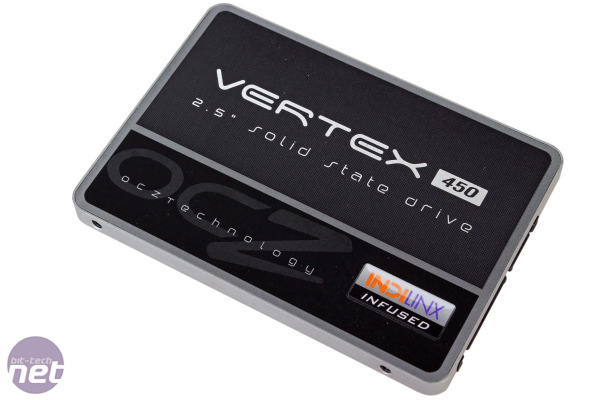Performance Analysis
In AS SSD, the Vertex 450 places 45MB/sec ahead of the Vertex 4 and only 11MB/sec behind the Vector in sequential reads, which is promising. However, in CrystalDiskMark, the same test actually shows the Vertex 4 as the faster drive. Samsung's SSD 840 Pro, meanwhile, is ahead in both, yet costs the same price as the Vertex 450. Sequential write speeds improve by between 10-15MB/sec over the Vertex 4 with an impressive maximum result of 518MB/sec. The Vector and SSD 840 Pro are both ahead again here, but only slightly.Unfortunately, random reads at a single queue depth are distinctly unimpressive, with the Vertex 450 placing bottom in both AS SSD and CDM. That said, the Vector was also pretty low in the standings here, with the Vertex 4's Everest 2 controller apparently better suited to such tasks than the Barefoot 3, and the SSD 840 Pro way ahead too. As the Barefoot 3 has been downclocked a little for the Vertex 450, it's not actually too surprising to see such a result. Thankfully, random writes are wholly different, as the three OCZ drives lead the way in both synthetic tests here, albeit with the Barefoot 3 based drives still lagging slightly behind the older Vertex 4.
At higher queue depths, random read performance again sees the Vertex 450 placing near the bottom of the graphs, although this time its speeds are on par with the Vertex 4 (but still way behind the more powerful Vector). Samsung's SSD 840 Pro is also faster, by 10 percent in AS SSD and 17 percent in CDM. Again, however, the Vertex 450 turns the tables when it comes to writes here, placing behind only the marginally faster Vector, and keeping a very small gap between itself and the 840 Pro.
The Vertex 450 gains a small lead over the Vertex 4 in our real world PCMark 7 Starting Applications test, although it only moves the result from 53.19MB/sec to 55.68MB/sec, which is far behind the 840 Pro with 67.02MB/sec. The gaming trace test goes even worse for the Vertex 450, as it falls to last place while the 840 Pro again takes first. Meanwhile, its result in BootRacer is more pleasing at 9.87 seconds; a fraction quicker than Samsung's drive and mid-leaugue overall. Filling the drive multiple times before running the TRIM command also had no negative effects on the results.
Conclusion
The key comparisons to make with the Vertex 450 are the drive it replaces, the Vertex 4, and the drive that it's priced to compete against, which is currently the Samsung SSD 840 Pro 256GB. With respect to the first, improvements are sadly not consistent, and the difference in low queue depth random read speeds is particularly disappointing. It's the latter comparison that makes it easiest to judge the OCZ drive, however. It may lead Samsung's in random writes, but the SSD 840 Pro is no slacker here either. Samsung's drive tends to have the advantage elsewhere, however, with much greater margins too – the real world PCMark 7 tests are a particular blow to the Vertex 450.The inclusion of Acronis True Image is a plus for the Vertex 450, but Samsung's free Data Migration tool also excels at easy OS install transfers. The South Korean giant has also promised Rapid Mode support for the 840 Pro in an upcoming version of its Magician software, which is clearly effective judging by its effect on the 840 Evo speeds. With the 840 Pro's extra two years warranty over OCZ's drive as well, the Vertex 450 really needs a price drop if it wants to remain competitive, as it's currently too expensive for the performance it offers.
-
Performance41 / 50
-
Features9 / 15
-
Value20 / 35


MSI MPG Velox 100R Chassis Review
October 14 2021 | 15:04










Want to comment? Please log in.